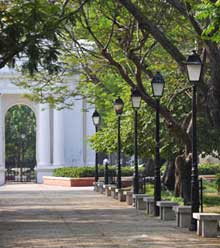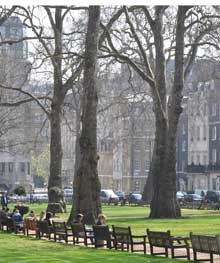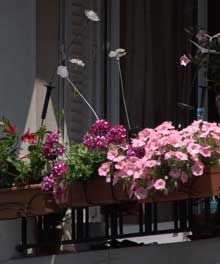Having spent a year in London I have by now got over my sense of wonder over the flowers in the front gardens, the fruit yoghurts and seeing sunlight in the sky at 9 pm. I have even got over my initial shock of seeing everyone dressed in black. But there is just one thing that continues to take my breath away. That is the sight of clean, empty, wide pavements.
I still marvel at the way I can walk from my house to the supermarket which is a kilometre and a half away without having to once step on to the road except when I have to cross over. The people walking alongside me on the perfectly level pavements know that this is the basic minimum a human being in an urban environment can expect. But for me this is absolute luxury.
As I walk back home I dream and reflect, since I don’t have the stress of having to negotiate the traffic. I float in nostalgia and remember how thirty years ago Pondicherry was just a sleepy town. True, there were no air-conditioned supermarkets, no cash machines and no satellite TV but how wonderful it was to have wide open roads where one could walk fearlessly.
Children actually walked to school if they did not go by bicycle. People went everywhere on foot, and if they really had to go very far they took a cycle rickshaw. There were so few cars that one could count them and autorickshaws were unheard of. The roads were not jammed up with parked cars and motorcycles. There used to be neat rows of cycles outside public buildings such as the General Post Office or banks.
But all that is a thing of the past now. Now it is common to see teenagers on scooters and everybody else on motor-cycles and cars. And the pedestrians? Well, there’s just no place for them. It is now too dangerous to walk. Everybody is on a motorised vehicle but how many have actually heard of the rules of the road? From the way the traffic moves, hardly anybody, it would seem. For example no one ever stops or even slows down near a cross-road. One can imagine how dangerous this is when one remembers that Pondicherry is actually built in a grid pattern so you can not take twenty steps without coming to a cross-road. What was supposed to make the town more organised has now become a nightmare.
The roads are full of speeding vehicles and the pavements are used for everything except what they were made for. Look around you and you will see that the space that should rightfully belong to the pedestrians is now hijacked by the hawkers, tea-stalls and phone-booths or parked vehicles. The new houses which are coming are more and more being built from the place where the road ends because very inch that is not the road must now be grabbed.
As one steps onto the street one finds that one third of the space has been taken by the parked vehicle and the two-thirds is taken up by traffic moving at high speed in both directions. So what does the poor pedestrian do? He is forced to steer himself in that same space where cars, motorcycles, scooters, bicycles and autorickshaws are engaged in a race.
The one thing that could be done without spending a great deal of money would be to make zebra crossings. Not all zebra crossings need traffic lights; there are some which are meant to be pedestrian crossings where those who are on foot have priority. But on second thoughts, zebra crossings are more than just a few stripes of white paint. They have to be respected and the vehicles will have to stop when anyone is crossing the road. And that is where we will fail. We just don’t know how to respect other people’s rights.
As I walk back from the supermarket in London I dream of seeing these same beautiful pavements in Pondicherry. How wonderful it would be if Indians too could slow down at cross-roads and stop to let pedestrians cross. In the meantime all I can do is look admiringly at the traffic islands and the priority pedestrian crossings. I still stand and gape as a tourist when I see the big red double-decker bus slow down to a stop when a bent old woman puts her foot forward on a pedestrian crossing to get to the other side of the road.


























